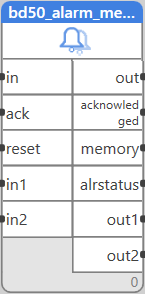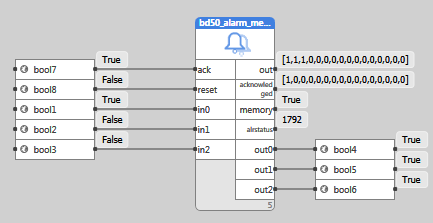Alarm memory
Block name
BD50_ALARM_MEMORY
ST call
PROGRAM TEST_BD50 VAR BOOL1, BOOL2, BOOL3, BOOL4, BOOL5, BOOL6:BOOL; FB : LIB.CORE.V1_0.BD50_ALARM_MEMORY; END_VAR FB.IN[1] := BOOL3; FB.IN[2] := BOOL4; FB(ACK:=BOOL1,RESET:=BOOL2); BOOL5 := FB.OUT[1]; BOOL6 := FB.OUT[2]; END_PROGRAM
Library
LIB\CORE
Version
V1.0
Description
The block is an alarm memory, with up to 16 alarms.
Inputs
| Input | Type | Description | Default value |
| IN | MULTIIOBOOL | Inputs of the alarm signals as an array | [False,…,False] |
| ACK | BOOL | Acknowledge. If IN=TRUE and rising edge comes to ACK then ACKNOWLEDGED=TRUE (while keeping MEMORY=TRUE) | False |
| RESET | BOOL | Reset of the alarm memory and ACKNOWLEDGED output. | False |
| IN0,IN1,..,IN15 | BOOL | Inputs of the alarm signals |
Outputs
| Output | Type | Description |
| OUT | MULTIIOBOOL | Alarm output signals as an array. |
| ACKNOWLEDGED | MULTIIOBOOL | Indication that an alarm has been acked |
| MEMORY | BOOL | Alarm memory |
| ALRSTATUS | INT | Status of the alarm block (bit 8 indicates IN=TRUE, bit 9 indicates ACKNOWLEDGED=TRUE, bit 10 indicates MEMORY=TRUE) |
| OUT0,OUT1,..,OUT15 | BOOL | Alarm output signals. OUT is in TRUE until an alarm has been reset. |
Function
This block is dedicated to deal with alarm states. The alarm signal is at the IN input. A rising edge on the IN input sets MEMORY to TRUE (alarm memory). The alarm can be reset by a rising edge at the RESET input. If IN=FALSE at the reset time, then MEMORY goes to FALSE. If the alarm is active (IN=TRUE), it can not be reset by the RESET input, but may be acknowledged by a rising edge brought to the ACK input. Note that in ST, the indeces are 1…16 rather than 0…15.
alrstatus values:
- alrstatus=256 - at least one alarm is active.
- alrstatus=512 - at least one alarm has been acknowledged
- alrstatus=1024 - memory = true, alarm was active but has not been reset.
The alrstatus value may be addition of more of these states.

